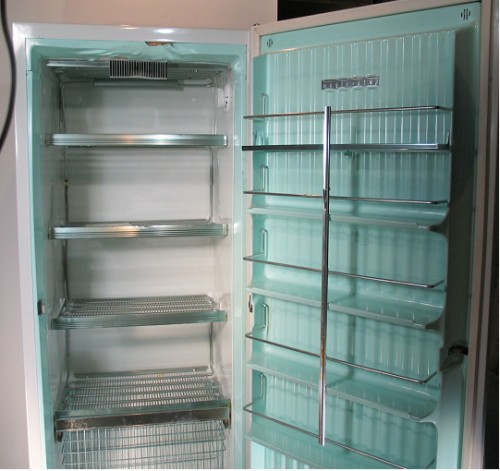Unitary Refrig and A/C Equipment and Systems – Household Cabinet Refrigerators
Modern Post World War II styling, in keeping with the design idiom of the day, square cornered, a departure from the smoothly rounded corners of the earlier Art Deco perod of the 1940’s
Technical Significance:
Unitary Refrigeration Equipment: The idea of a unitary piece of refrigeration or air conditioning equipment was a significant one in its own right, one that had to wait its time. The scientists, engineers and inventors in the early years of the 20th century were intrigued and obsessed with the power of the technology and of its possible market potential. What they saw was the newly discovered principles of physics and heat engines – following, for example, the early works of Carnot, Faraday, Kelvin, and the later work of Perkins, Larsen and Carrier, to name a few. They understood the promise of the technology for the public good, not to say its consumer sales potential. Early engineering work advanced on a multiple fronts with development of compressors, heat exchangers, valves and piping variously strung together in configurations that would be found to work, but only after much experimentation.
The arrival of unitary equipment, all those parts organised into a single whole, a single unit of construction, a “black box”, that could be offered to the consumer market was a significant technological and cultural event. Technologically the refrigerator would need to be seen to be safe, reliable, maintainable and useful. As well, in order to attract the development capital needed, it must be seen as potentially saleable and affordable, contributing to life’s needs and desires. Its socio- cultural and economic significance was marked, for it would change much. As Canadians we would quickly come enjoy potentially healthier lives, expect new levels of comfort and convenience, with a broader, safer, more diverse and enjoyable diet.
As a result, Canadians would quickly come to think of their day differently, for the day would be defined and punctuated in different ways than ever before, as a result of the introduction of modern, electric, household appliances, of which refrigerators, freezers and room air conditioners would be a central part, by the mid 20th century
J. M Larsen produced a manually operated household refrigerator of sorts in 1913, but it was not until 1918 that the Kelvinator Company marketed the first automatic, unitary refrigerator for the home. In that year, it is reported to have sold sixty-seven machines. (See Note 1) The historic artifacts in Group 1.00, Unitary Equipment, including significant samplings the early work of Kelvinator of Canada, provide a rare view of the evolution of unitary refrigeration and air conditioning applications, as they evolved in Canada in the first half of the 20th century.
For those formative years, the artifacts in this Group, 1.00, are typical of the offerings of the Canadian refrigeration and air conditioning industry. They personified the applications found in the homes, farms and commercial premises of the period for, those that could afford life’s new amenities of comfort, convenience and privilege.
This Specimen: The advent of the vertical home freezer, as represented here by an acknowledged market leader of the period, Kelvinator, made possible and accelerated a significant movement in the consumer culture of the 1950’s and 60’s. It moved Canadian society and culture solidly into pre-packaged, frozen foods, one of the hall-marks of the dietary and consumer cultures of the last half of the 20th century.
Industrial Significance:
The long life, trouble and maintenance free, refrigerating technolgy represented in this machine [50 years] and others of the period, marked a plateau in the field, an achievement almost unimagined a decade earlier. This now historic artifact of canada’s material culture of technology stands as a prime offering of Canada’s golden age of appliance manufacturing [See also THOC-HVACR-004]. The engineering and production of this line of consumer products by Kelvinator of Canada would mark the maturity and decline of the company as a pioneer in the Canadian refrigeration and appliance industry. Competitive pressures and the changing nature of the market place would make it difficult for small innovative manufactures like Kelvinator of Canada to survive. Within a few years the company would be sold to a large corporate conglomerate, and the name Kelvinator would soon become a marketing label and little more.


